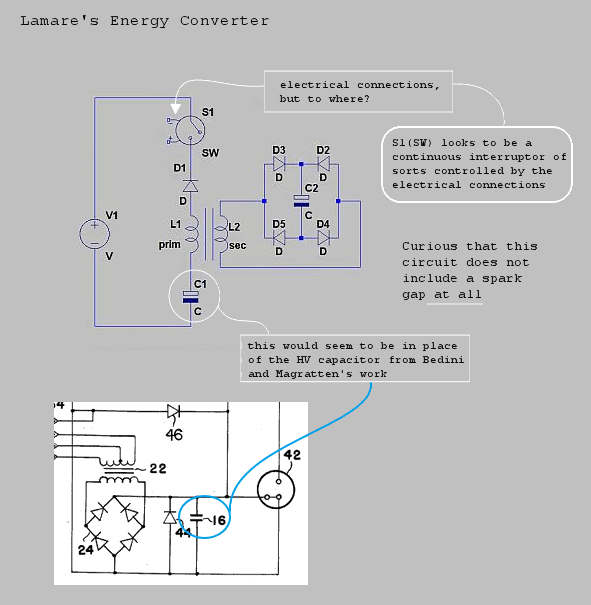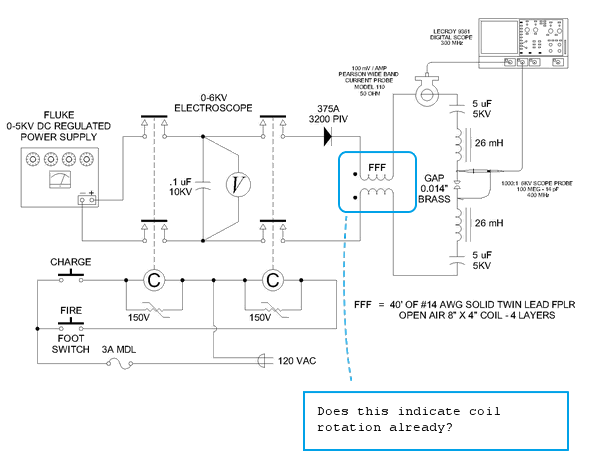Promised Photos
Dear Nat,
OK here are the photos of the present round of experiments. First off is a series of Scope Traces to show the opserved impact of the FFF in this Tesla Equi-Drive layout. All of these presented traces are taken from the Perason Model 110 Wide Band Current Transformer, so they are suppose to be current measurements. The peak current is 2.35 Amps, that 46 mH of series inductance sure cuts down the current flow. All of these traces are done with single pulses ("shots").
D005 - This is what I have observed in my setup using the larger contactors. One is used to charge the storage capacitor the other is used to "Fire" the capacitor. This allows for complete isolation of the discharging capacitor. In this experiment I'm using a .25 uF capacitor. Notice all the "Hash" as the current rises. Now these numerous pulses riding on my current wave form can't be classical current. Something else is going on. The current can't change that fast with that much series inductance. The probe is picking up something else - and I dont know what it is or how it gets there. But they are repeatable and consistant from shot to shot. What is interesting is that they only take place while the current across the spark gap is rising.
D006 - By decreasing the time scale t0 5 us/div we can see that this "Hash" is composed of individual bursts that last about 3-4 uS.
D007 - Decreasing the time scale to 1 us/div we can see the peak magnitude of the initial components of the burst. It is about 1.6 Amps if it were really a current measurement.
D008 - Decreasing the time scale to 20 nano-seconds we can see the structure of the burst packet. It is composed of 4 frequencies that each turn on an off in their own order. This is not a linear response so part of the source of this observation must come form some interaction with the spark - unless I'm looking at some kind of instrument artifact.
D009 - This is the clincher. This trace is with the FFF removed. Notice that the "Hash" is gone. All the other components are the same and still in the circuit. This implies that the the FFF is the source to the "Hash". Actually I think it is its interaction with the arc and all the other components in this proposed setup. Again I still could be looking at some kind of instrument artifact or other distracting interferance.
The photo is the present setup with the older and smaller contactor. I shall post another message with additional detail photos.
Mark McKay
Originally posted by nat1971a
View Post
OK here are the photos of the present round of experiments. First off is a series of Scope Traces to show the opserved impact of the FFF in this Tesla Equi-Drive layout. All of these presented traces are taken from the Perason Model 110 Wide Band Current Transformer, so they are suppose to be current measurements. The peak current is 2.35 Amps, that 46 mH of series inductance sure cuts down the current flow. All of these traces are done with single pulses ("shots").
D005 - This is what I have observed in my setup using the larger contactors. One is used to charge the storage capacitor the other is used to "Fire" the capacitor. This allows for complete isolation of the discharging capacitor. In this experiment I'm using a .25 uF capacitor. Notice all the "Hash" as the current rises. Now these numerous pulses riding on my current wave form can't be classical current. Something else is going on. The current can't change that fast with that much series inductance. The probe is picking up something else - and I dont know what it is or how it gets there. But they are repeatable and consistant from shot to shot. What is interesting is that they only take place while the current across the spark gap is rising.
D006 - By decreasing the time scale t0 5 us/div we can see that this "Hash" is composed of individual bursts that last about 3-4 uS.
D007 - Decreasing the time scale to 1 us/div we can see the peak magnitude of the initial components of the burst. It is about 1.6 Amps if it were really a current measurement.
D008 - Decreasing the time scale to 20 nano-seconds we can see the structure of the burst packet. It is composed of 4 frequencies that each turn on an off in their own order. This is not a linear response so part of the source of this observation must come form some interaction with the spark - unless I'm looking at some kind of instrument artifact.
D009 - This is the clincher. This trace is with the FFF removed. Notice that the "Hash" is gone. All the other components are the same and still in the circuit. This implies that the the FFF is the source to the "Hash". Actually I think it is its interaction with the arc and all the other components in this proposed setup. Again I still could be looking at some kind of instrument artifact or other distracting interferance.
The photo is the present setup with the older and smaller contactor. I shall post another message with additional detail photos.
Mark McKay


Comment